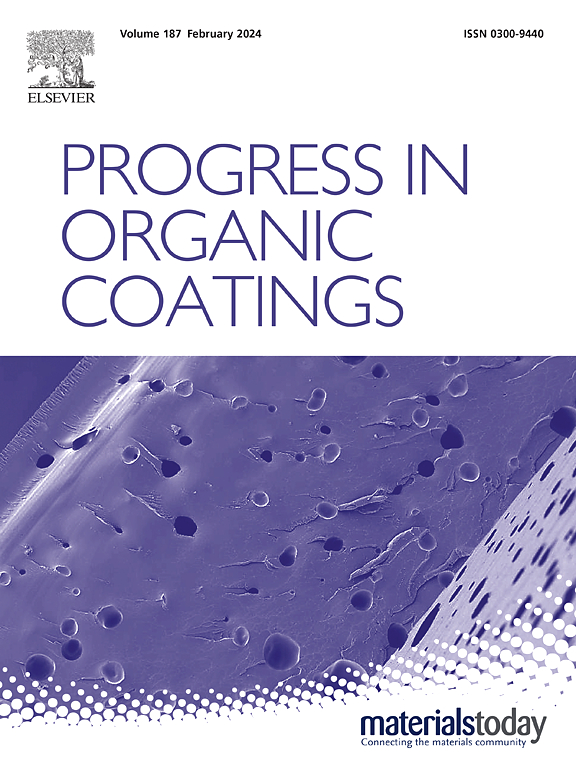Facile fabrication of tear-film-inspired durable hyaluronic acid hydrogel films for persistent anti-fogging
IF 7.3
2区 材料科学
Q1 CHEMISTRY, APPLIED
引用次数: 0
Abstract
Hydrophilic anti-fogging coatings face dual challenges of insufficient water resistance and poor weathering durability in practical applications. To address these issues, we propose a natural composite coating system integrating hyaluronic acid (HA), glycerol (Gly), FeCl3, and zinc oxide nanoparticles (ZnO-NPs) via a facile mixing strategy. Inspired by the mucin-mediated hydration dynamics of tear films, the HA framework constructs a self-replenishing layer to inhibit fogging while achieving underwater oleophobicity through surface hydration, effectively repelling oily contaminants. Glycerol maintains flexibility and hydration equilibrium through hydrogen-bonded water retention, whereas FeCl3 crosslinking enhances mechanical strength and water stability via dynamic coordination bonds emulating tear film's ion-modulated self-repair, thereby resisting hydration-induced degradation. ZnO-NPs further endow the coating with photo-induced hydrophilicity. The optimized coating exhibits exceptional water resistance, weathering durability, and mechanical robustness, retaining high transmittance and stable hydrophilicity after 120 h of water immersion, 120 h of xenon lamp irradiation, 40 adhesion cycles, and 300 abrasion tests. Remarkably, the coating demonstrates rapid self-healing within 10 s and superior self-cleaning performance. This study proposes a sustainable strategy to synergistically enhance water resistance and weathering resistance.

泪膜启发的持久抗雾透明质酸水凝胶膜的简单制造
亲水防雾涂料在实际应用中面临着耐水性不足和耐候性差的双重挑战。为了解决这些问题,我们提出了一种天然复合涂层系统,通过简单的混合策略将透明质酸(HA)、甘油(Gly)、FeCl3和氧化锌纳米颗粒(ZnO-NPs)整合在一起。受黏液介导的泪液膜水化动力学的启发,透明质酸框架构建了一个自我补充层,以抑制雾气,同时通过表面水化实现水下疏油,有效地排斥油性污染物。甘油通过氢键保水来维持柔韧性和水合平衡,而FeCl3交联通过动态配位键模拟泪膜离子调节的自我修复来增强机械强度和水稳定性,从而抵抗水合诱导的降解。ZnO-NPs进一步赋予涂层光致亲水性。优化后的涂层具有优异的耐水性、耐候性和机械坚固性,在120小时的水浸、120小时的氙灯照射、40次粘附循环和300次磨损试验后,仍保持高透光率和稳定的亲水性。值得注意的是,该涂层在10 s内具有快速自愈和良好的自清洁性能。本研究提出了一种可持续的策略,以协同提高耐水性和耐风化性。
本文章由计算机程序翻译,如有差异,请以英文原文为准。
求助全文
约1分钟内获得全文
求助全文
来源期刊

Progress in Organic Coatings
工程技术-材料科学:膜
CiteScore
11.40
自引率
15.20%
发文量
577
审稿时长
48 days
期刊介绍:
The aim of this international journal is to analyse and publicise the progress and current state of knowledge in the field of organic coatings and related materials. The Editors and the Editorial Board members will solicit both review and research papers from academic and industrial scientists who are actively engaged in research and development or, in the case of review papers, have extensive experience in the subject to be reviewed. Unsolicited manuscripts will be accepted if they meet the journal''s requirements. The journal publishes papers dealing with such subjects as:
• Chemical, physical and technological properties of organic coatings and related materials
• Problems and methods of preparation, manufacture and application of these materials
• Performance, testing and analysis.
 求助内容:
求助内容: 应助结果提醒方式:
应助结果提醒方式:


